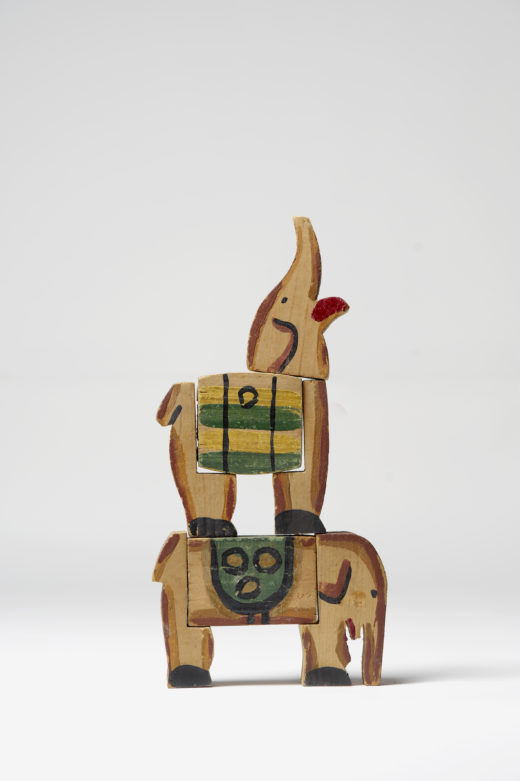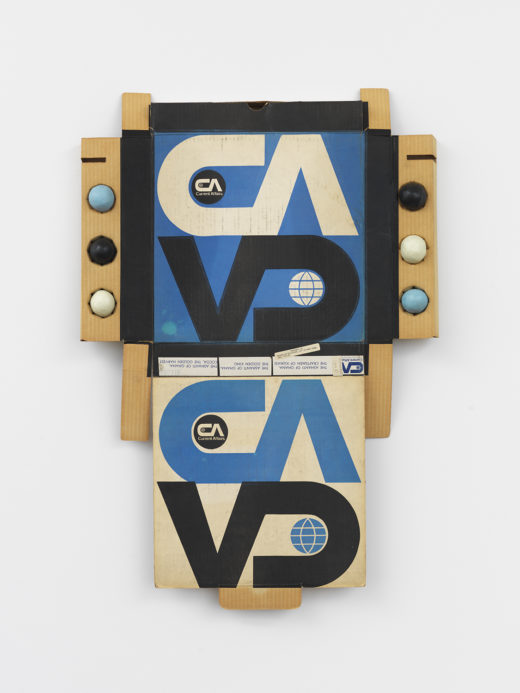- A New Day Has Come: A Review of Radical Hope: Letters of Love and Dissent in Dangerous Times

- Gal Weinstein: Israeli Pavilion 57th Venice Biennale
Activating Objects: The Art of Play, Part I
Laila Pedro
 Joaquín Torres-García, Un Elefante, c. 1928. Oil on wood, 11 pieces, dimensions variable. Courtesy the Estate of Joaquín Torres-García. Photo: Arturo Sanchez, Courtesy Cecilia de Torres, Ltd.
Joaquín Torres-García, Un Elefante, c. 1928. Oil on wood, 11 pieces, dimensions variable. Courtesy the Estate of Joaquín Torres-García. Photo: Arturo Sanchez, Courtesy Cecilia de Torres, Ltd.
March 15–July 12, 2017
The map of childhood, so frequently idealized in the common imagination as a bucolic landscape of innocence and freedom, is more frequently the terrain of nightmares. To examine childhood, relieved of the veil of adult nostalgia, is to recall an experience of being small and helpless, confused and bemused, seduced and perturbed, terrorized by one’s own budding imagination. Within this darkling country, children find play not only as a means of escape but also of control—a way to imagine themselves into kingdoms of their own making, to scale the world to their own parameters. Children’s games are rife with death and danger: “Ring around the Rosie” was a whistle in the dark in the face of the Black Death; for preteens in the 1980s and ‘90s, Truth or Dare pushed the limits of fear and daring and attempted to demystify and delimit the boundaries of social behavior. In the adult commercial realm, it’s common to refer to sexual accessories as “toys,” as though imbuing them with a childlike vernacular takes the Thanatos out of the Eros.
At ANOTHER SPACE, a not-for-profit program in Chelsea, Estrellita B. Brodsky, a longtime champion of art from Latin America, presents Activating Objects: The Art of Play, an exhibition curated by Mauricio Marcín that ingeniously and comprehensively surveys artists’ notions of games and play, and their fruitful juxtapositions of darkness and light. It’s an intriguingly conceived, interactive, immersive show that allows the viewer to negotiate the titillating razor’s edge between fun and fear.
If Activating Objects has a deeply psychoanalytic character, it also has a phenomenological resonance grounded in the complexities of human neurological development, which illuminates the ways in which both art and play shape our minds. This juxtaposition between the somatic and the psychological is strongly present in two works by Lygia Clark, Bicho Caranguejo Duplo, a toy the Brazilian artist first designed in 1960, and Memória do corpo, a video from 1984. Bicho is an uncannily organic-seeming, origami-like structure of metal and hinges. Viewers are encouraged to play with its collapsible parts and reconfigure them into different shapes (a delightfully cheeky sign on the table where it’s displayed reads “Please Touch”). Far from being an anodyne modular Lego construction—passive, receptive—the Bicho likes to snap in on itself or on the viewer’s hand without warning. In Brodsky’s words, “it bites back.”
This notion of a toy as something with a capacity for agency that is not necessarily benevolent presents an interesting parallel to the practice and condition of viewing art: like play, like toys, it is an experience that is, even if on a very subtle level, interactive, tactile, and responsive. The way a child plays with building blocks, or the way an adult plays with the Bicho, are both deeply haptic, embodied, neutrally engaged actions that shift one’s positional relationship to the world. This embodied interaction with art is more literally on display in Memoria do corpo, in which Clark uses some of her familiar ball-and-net-bag forms to explain a kind of therapy she developed for her own mind and body. The tactility is deeply affecting, and suggests that any kind of healing must involve the openness of invention and play.
Examples of Surrealist jokes, pranks, and play abound in this exhibition, including games incorporating symbols and language. The punning of the Surrealists and wordplay of the concrete poets, specifically Stéphane Mallarmé, are cleverly exploited in Décio Pignatari’s bebe coca cola (1957/64) and in Augusto de Campos’s lygia fingers (1953/64), both of which regroup and reorder words graphically to yield new combinations and possibilities—sometimes resulting in nonsense, sometimes in jokes or excavations of desire. Xul Solar’s works from the early-to-mid-twentieth century are wondrous reinventions of existing systems (tarot deck, chessboard, I Ching) that play with both the safety of recognizing the structures and gestures behind these systems, and with the dislocation—and potential excitement—of realizing, upon closer inspection, that these are not what we thought them to be and are therefore both affecting and completely indecipherable.
Activating Objects is an ambitious show, broad in both historical and artistic scope. It is worth making an appointment to visit if only to witness the wonderfully sophisticated wooden toys of Joaquín Torres-García, which are at once terribly adult and gleefully, childishly fun.

Gabriel Orozco, Penske Work Project: Current Affairs, The Golden King, 1998. Cardboard, Plasticene. Courtesy of the artist and Marian Goodman Gallery. Photo: Object Studies. Courtesy ANOTHER SPACE
Activating Objects offers an encounter with liminal, fraught spaces and the humor human beings use to engage with them. By presenting artworks as activated objects and bringing a sense of play to the viewer’s role, the show reminds us of one of the most significant things art––and artists––can offer: new ways to game the system.
Laila Pedro is an editor and writer based in New York. She holds a Ph.D. in French and is currently at work on a book about artistic connections among Cuba, France, and the Francophone Caribbean.









